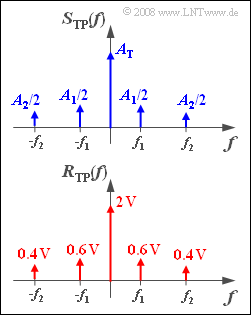Exercise 2.9: Symmetrical Distortions
The source signal made up of two components
- $$q(t) = A_1 \cdot \cos(2 \pi f_1 t ) + A_2 \cdot \cos(2 \pi f_2 t )$$
is amplitude modulated and transmitted through a linearly distorting transmission channel.
- The carrier frequency is $f_{\rm T}$ and the added DC component $A_{\rm T}$.
- Thus, a "double-sideband amplitude moduluation" $\rm (DSB–AM)$ with carrier" is present.
The upper graph shows the spectrum $S_{\rm TP}(f)$ of the equivalent low-pass signal in schematic form. This means that the lengths of the Dirac delta lines drawn do not correspond to the actual values of $A_{\rm T}$, $A_1/2$ and $A_2/2$.
The spectral function $R(f)$ of the received signal was measured. In the lower graph we can observe the equivalent low-pass spectrum $R_{\rm TP}(f)$ calculated from this.
The channel frequency response is characterized with sufficient accuracy with a few auxiliary values:
- $$ H_{\rm K}(f = f_{\rm T}) = 0.5,$$
- $$H_{\rm K}(f = f_{\rm T} \pm f_1) = 0.4,$$
- $$ H_{\rm K}(f = f_{\rm T} \pm f_2) = 0.2 \hspace{0.05cm}.$$
Hints:
- This exercise belongs to the chapter Envelope Demodulation.
- Particular reference is made to the section Description using the equivalent low-pass signal.
Questions
Solution
- $${A_{\rm T}} \cdot 0.5 = 2 \,{\rm V}\hspace{0.3cm} \Rightarrow \hspace{0.3cm}A_{\rm T} \hspace{0.15cm}\underline {= 4 \,{\rm V}},$$
- $${A_{\rm 1}}/{2} \cdot 0.4 = 0.6\,{\rm V}\hspace{0.3cm} \Rightarrow \hspace{0.3cm}A_{\rm 1} \hspace{0.15cm}\underline {= 3 \,{\rm V}},$$
- $${A_{\rm 2}}/{2} \cdot 0.2 = 0.4\,{\rm V}\hspace{0.3cm} \Rightarrow \hspace{0.3cm}A_{\rm 2} \hspace{0.15cm}\underline {= 4 \,{\rm V}}\hspace{0.05cm}.$$
(2) Answer 3 is correct:
- The resulting modulation depth is $m = (A_1 + A_2)/A_T = 1.75 >1$.
- This leads to strong nonlinear distortion when using an envelope demodulator.
- A distortion factor cannot be specified because the source signal contains two frequency components.
(3) Answers 1 and 2 are correct:
- The Fourier retransform of $R_{\rm TP}(f)$ gives us the result:
- $$ r_{\rm TP}(t) = 2 \,{\rm V} + 1.2 \,{\rm V} \cdot \cos(2 \pi f_1 t ) + 0.8 \,{\rm V} \cdot \cos(2 \pi f_2 t )\hspace{0.05cm}.$$
- This function is always real and non-negative.
- Thus, $ϕ(t) = 0$ holds simultaneously, whereas $ϕ(t) = 180^\circ$ is not possible.
(4) A comparison of the two signals
- $$q(t) = 3 \,{\rm V} \cdot \cos(2 \pi f_1 t ) + 4 \,{\rm V} \cdot \cos(2 \pi f_2 t ),$$
- $$ v(t) = 0.4 \cdot 3 \,{\rm V} \cdot \cos(2 \pi f_1 t ) + 0.2 \cdot 4 \,{\rm V} \cdot \cos(2 \pi f_2 t )$$
- shows, that linear (attenuation) distortions now arise ⇒ Answer 2.
- Here, the channel $H_{\rm K}(f)$ has the positive effect, that instead of irreversible nonlinear distortions, only linear distortions arise, and these can be eliminated by a downstream filter.
- This is due to the fact that the higher attenuation of the source signal $q(t)$ compared to the carrier signal $z(t)$ lowers the modulation depth from $m = 1.75$ to
- $$m = (0.4 · 3 \ \rm V + 0.2 · 4 \ \rm V)/(0.5 · 4 \ \rm V) = 1.$$
